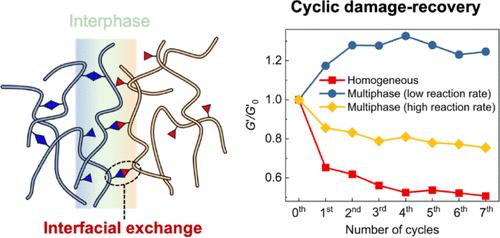多相Vitrimers界面交换反应动力学及流变行为的研究
IF 5.2
1区 化学
Q1 POLYMER SCIENCE
引用次数: 0
摘要
下一代热塑性硫化胶(TPVs)采用由具有不同交联密度的玻璃体网络构成的多相结构,其中加速的界面网络松弛在高通量后处理(例如挤出)中具有独特的优势。然而,原始网络之间交联密度的差异和界面相展宽对多相vitrimers的粘弹性和界面弛豫行为的影响尚不清楚。为了系统地评价接枝密度和交联密度对界面交换动力学的影响,建立了由单二氧代硼烷接枝和双氧代硼烷交联苯乙烯-丁二烯橡胶(SBR)组成的模型多相玻璃聚合物体系。研究表明,应力超调和界面松弛均受界面相展宽和交联密度反差的控制。当两个原始网络之间的对比显著时,界面弛豫在界面展宽的长时间尺度上持续存在,而对比不显著,界面弛豫仅限于界面展宽的短时间尺度。此外,界面交换程度的增加和分散相交联密度的增加都加剧了循环后处理过程中不可逆的结构损伤。这些发现表明,利用界面弛豫进行高效挤压再加工的多相玻璃体需要合理控制组分结构和加工/退火时间窗,为其优化和应用提供了理论指导和设计准则。本文章由计算机程序翻译,如有差异,请以英文原文为准。

Understanding the Interfacial Exchange Reaction Kinetics and Rheological Behavior of Multiphase Vitrimers
Next-generation thermoplastic vulcanizates (TPVs) employ a multiphase architecture constructed from vitrimeric networks with distinct cross-linking densities, where accelerated interfacial network relaxation confers unique advantages during high-throughput reprocessing (e.g., extrusion). Nevertheless, the influences of disparity in cross-linking density between the original networks and of interphase broadening on the viscoelastic and interfacial relaxation behaviors of multiphase vitrimers remain poorly understood. Here, a model multiphase vitrimer system consisting of monodioxaborolane-grafted and bis-dioxaborolane-cross-linked styrene–butadiene rubber (SBR) was developed to systematically evaluate the effects of grafting density and cross-linking density on interfacial exchange kinetics. The investigation reveals that stress overshoot and interfacial relaxation are both governed by interphase broadening and cross-linking density contrast. When the contrast between the two original networks is significant, interfacial relaxation persists over long time scales of interfacial broadening, whereas the contrast is insignificant, and interfacial relaxation is limited to short time scale of interfacial broadening. Moreover, increasing interfacial exchange extent and dispersed phase cross-linking density both exacerbate irreversible structural damage during cyclic reprocessing. These findings imply that multiphase vitrimers designed to exploit interfacial relaxation for efficient extrusion reprocessing require judicious control of the component structure and processing/annealing time windows, providing theoretical guidance and design criteria for their optimization and applications.
求助全文
通过发布文献求助,成功后即可免费获取论文全文。
去求助
来源期刊

Macromolecules
工程技术-高分子科学
CiteScore
9.30
自引率
16.40%
发文量
942
审稿时长
2 months
期刊介绍:
Macromolecules publishes original, fundamental, and impactful research on all aspects of polymer science. Topics of interest include synthesis (e.g., controlled polymerizations, polymerization catalysis, post polymerization modification, new monomer structures and polymer architectures, and polymerization mechanisms/kinetics analysis); phase behavior, thermodynamics, dynamic, and ordering/disordering phenomena (e.g., self-assembly, gelation, crystallization, solution/melt/solid-state characteristics); structure and properties (e.g., mechanical and rheological properties, surface/interfacial characteristics, electronic and transport properties); new state of the art characterization (e.g., spectroscopy, scattering, microscopy, rheology), simulation (e.g., Monte Carlo, molecular dynamics, multi-scale/coarse-grained modeling), and theoretical methods. Renewable/sustainable polymers, polymer networks, responsive polymers, electro-, magneto- and opto-active macromolecules, inorganic polymers, charge-transporting polymers (ion-containing, semiconducting, and conducting), nanostructured polymers, and polymer composites are also of interest. Typical papers published in Macromolecules showcase important and innovative concepts, experimental methods/observations, and theoretical/computational approaches that demonstrate a fundamental advance in the understanding of polymers.
 求助内容:
求助内容: 应助结果提醒方式:
应助结果提醒方式:


